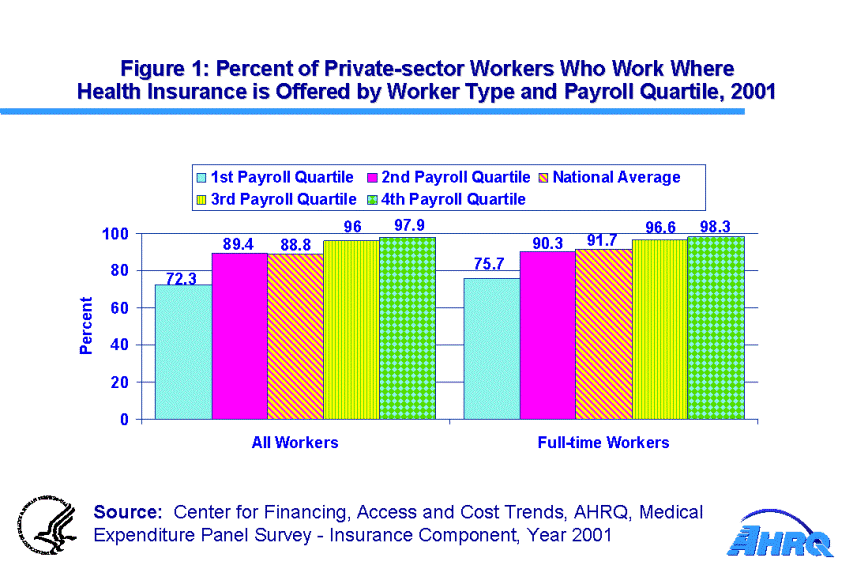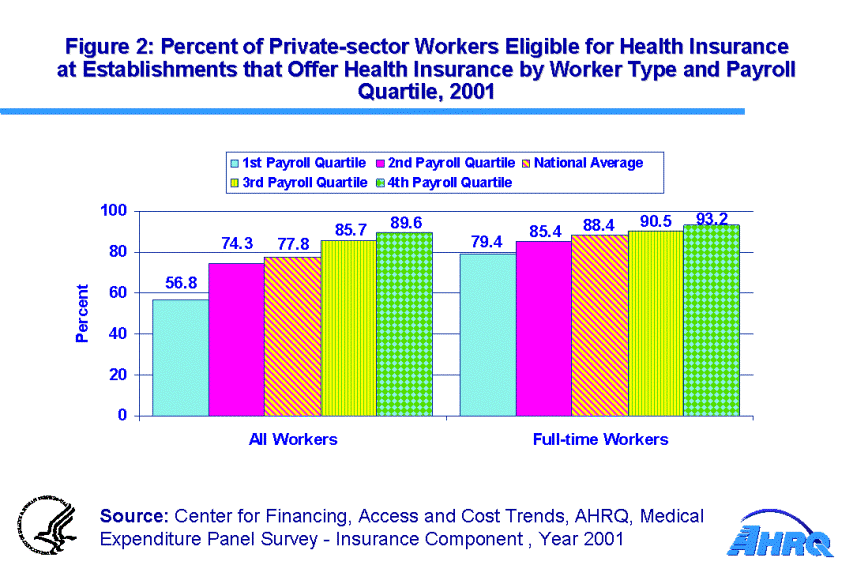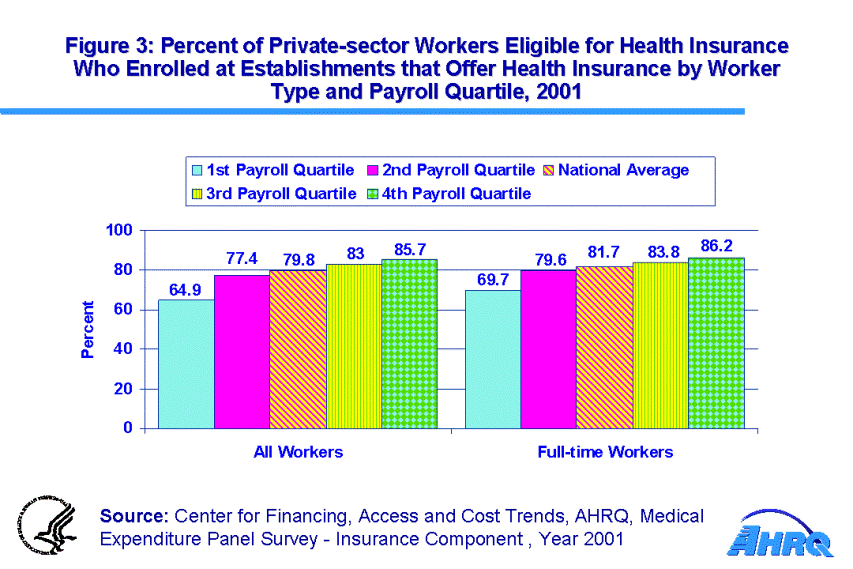
|
|
Font Size:
|
||||
|
|
|
|
||||
STATISTICAL BRIEF #25:
Employer-Sponsored Health Insurance Characteristics by Average Payroll for the Private Sector in 2001
Briefly Stated
- Without exception, the offer, eligibility, and enrollment rates increased across the payroll quartiles--these rates are lowest for the first payroll quartile and highest for the highest payroll quartile.
- The type of coverage (single or family) that employees selected also varied by compensation level. For example, the rate of enrollment in single coverage among all enrolled employees was highest for the first payroll quartile, second highest for the second payroll quartile, and lowest for the highest payroll quartile.
- Average annual employee contributions toward premiums for both single and family coverage declined as the payroll quartile rose. The highest average contributions were required of the employees in the lowest payroll quartile, and the lowest contributions were observed for employees in the highest payroll quartile.
Introduction
One of the primary sources of health coverage in the United States is coverage provided through employers for their current employees. According to data from the 2001 Medical Expenditure Panel Survey Insurance Component (MEPS-IC), approximately 63 million of the 114 million employees from the private sector are enrolled in a health insurance plan sponsored by their employers.
Many factors are correlated with whether an employee has access to a health insurance plan sponsored by his or her employer and, if so, whether the employee enrolls and what the employee contributes toward the cost of this coverage. Employer characteristics commonly acknowledged to correlate with characteristics of employer-sponsored health insurance include the size of the employer, the industry, the presence of a union, and the level of employee compensation.
This analysis of data from the 2001 MEPS-IC examines the offer, eligibility, and enrollment rates and level of employee contributions for private-sector establishments grouped by the average payroll per employee (compensation excluding fringe benefits). Each group or quartile contains 25% of the total number of employees in the private sector, and each group represents establishments with progressively higher average payrolls. Thus, the first group contains 25% of total employment in all the establishments, comprising those establishments with the lowest average payroll per employee. Additional details on the grouping methodology are contained in the definitions section of this report.
This analysis compares the offer, eligibility, and enrollment rates and contributions of private-sector employees toward employer-sponsored health insurance for these quartiles. Only those differences that are statistically significant at the .05 level are discussed.
Findings
In 2001, 72.3% of all employees in the first payroll quartile, 89.4% of those in the second payroll quartile, 96.0% of those in the third payroll quartile, and 97.9% of those in the fourth payroll quartile worked where health insurance was offered (Figure 1). Because part-time employees generally are not offered coverage, rates were also examined for full-time employees to remove the effects caused by differing numbers of part-time employees in each of the quartiles. Regardless of whether the data examined were for all employees or for full-time employees only, the percent who worked where health insurance was offered went up significantly from the first to the second quartile and from the second to the third quartile. The rates were also higher for the fourth quartile compared to the third quartile, but differences were not significant.
The percent of employees eligible for health insurance in establishments that offer health insurance followed this same pattern for all employees and full-time employees. As shown in Figure 2, only 79.4% of full-time employees were eligible for health insurance in the first payroll quartile, while 93.2% were eligible in the fourth payroll quartile, which had the highest average payrolls.
Employers control whether health insurance is offered and who is eligible. As shown in Figure 3, when employees had a choice to enroll in employer-sponsored health insurance, the enrollment rates rose with increasing payroll quartiles. Among all eligible employees in the establishments in the first payroll quartile, only 64.9% enrolled in health insurance, compared to 77.4% in the second quartile, 83.0% in the third quartile, and 85.7% in the fourth quartile.
Considering the offer (72.3%), eligibility (56.8%), and enrollment (64.9%) rates in the first payroll quartile, shown in Figures 1, 2, and 3, respectively, the percent of all employees who were enrolled in employer-sponsored health insurance in 2001 was approximately 26.7% (72.3% times 56.8% times 64.9%). The same values for the second, third, and fourth payroll quartiles were approximately 51.4%, 68.3%, and 75.2%, respectively.
The type of coverage (single or family) that employees selected also varied by compensation level. The enrollment rates for single coverage of 56.2% for the first quartile and 51.5% for the second quartile were much higher than the national average of 46.3% (Figure 4). The rate for the third quartile was 44.8%, which did not significantly differ from the national average. For the fourth payroll quartile, the value was 40.5%, which was significantly lower than the national average.
Figure 5 shows that contributions toward premiums for both single coverage and coverage for a family of four follow a descending pattern from the first to the fourth payroll quartile. The higher the average payroll per employee, the lower the average contribution per employee for employer-sponsored health insurance. Single contributions fall from $672 per enrollee for the first quartile to $409 for the fourth quartile. Likewise, across the groups, the employee contribution toward the premium for a family of four falls from $2,075 to $1,580.
Definitions
Quartiles
Quartiles are groups of establishments, each which contains 25% of the total employment. The following process was used to determine the establishments within each of these employment quarters or quartiles:
- The establishments were placed in order from lowest to highest average payroll per employee.
- Starting with the lowest establishment, the employment was summed until the cumulative employment of the establishments on the list was 25% of the total employment of all establishments. The establishments on the list to that point are considered to be in the first quartile.
- The second quartile begins with the next establishment on the list and includes all establishments from that point on the list until the cumulative employment reaches 50%.
- The third quartile includes all establishments after the second quartile and ends with the establishment that brings the cumulative employment to 75% of the total.
- The fourth quartile includes all establishments above the third quartile.
Establishment
In this statistical brief, an establishment is defined as a single business location. Multiple establishments can be controlled by a single entity denoted as a firm. Establishments from the same firm can be in different payroll quartiles as defined above.
Payroll
Payroll includes all forms of compensation, such as salaries, wages, commissions, dismissal pay, bonuses, and employee contributions to pension plans. Payroll excludes fringe benefits. This definition is the same as used by the Internal Revenue Service on Form 941.
About MEPS-IC
The MEPS-IC is a survey of business establishments and governments that collects information on employer-sponsored health insurance, such as whether insurance is offered, enrollments, types of plans, and premiums. The survey is conducted annually by the U.S. Bureau of the Census under the sponsorship of the Agency for Healthcare Research and Quality (AHRQ). The yearly response rate has averaged 78% for in-scope sample units. (Approximately 4% of the original sample is out-of-scope in a typical year.) A total sample of 42,000 establishments was selected for the 2001 survey, prior to accounting for losses due to non-response and out-of-scope (primarily out-of-business) cases. For more information on this survey, see MEPS Methodology Reports 6, 8, and 10 and the MEPS-IC Technical Appendix, available on the MEPS Web site: http://www.meps.ahrq.gov.
 |
||||||||||||||||||||||||
|
||||||||||||||||||||||||
|
|
||||||||||||||||||||||||
 |
||||||||||||||||||||||||
|
||||||||||||||||||||||||
|
|
||||||||||||||||||||||||
 |
||||||||||||||||||||||||
|
||||||||||||||||||||||||
|
|
||||||||||||||||||||||||
 |
||||||||||||||||||||||||
|
||||||||||||||||||||||||
|
|
||||||||||||||||||||||||
 |
||||||||||||||||||||||||
|
||||||||||||||||||||||||
|
|
||||||||||||||||||||||||


